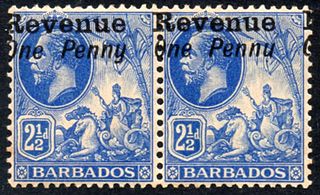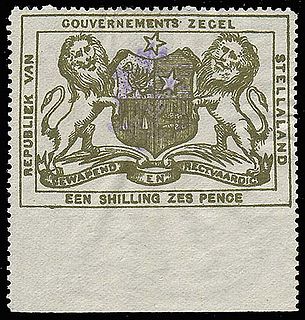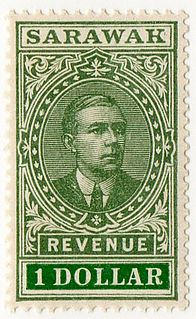
Batumi is a city on the Black Sea coast and capital of Adjara, an autonomous republic in southwest Georgia. The city was under Russian rule at the beginning of World War I, but local unrest led to Turkey entering the city in April 1918, followed by the British in December, who stayed until July 1920.

Governing authorities in the Philippines have issued a variety of stamps for internal revenue taxes and other fiscal taxes since 1856. Prior to 1856, internal revenues were collected via stamped paper. Revenue stamps for the Philippines were issued by the Spanish East Indies government (1856–1898), the revolutionary government of the First Philippine Republic (1898–1901), the Insular Government of the United States (1901–1935), the government of the Commonwealth of the Philippines, the Philippine Executive Commission (1942–44) and the Republic of the Philippines (1946–present).

Revenue stamps of the United Kingdom refer to the various revenue or fiscal stamps, whether adhesive, directly embossed or otherwise, which were issued by and used in the Kingdom of England, the Kingdom of Great Britain, the United Kingdom of Great Britain and Ireland and the United Kingdom of Great Britain and Northern Ireland, from the late 17th century to the present day.

The British colony of Aden, which is now part of Yemen, issued revenue stamps from 1937 to around 1945. Prior to having its own issues, Aden had used revenue stamps of India.

Revenue stamps of Ireland refer to the various revenue or fiscal stamps, whether adhesive, directly embossed or otherwise, which have been used on the island of Ireland since 1774. These include issues by the Kingdom of Ireland, issues by the United Kingdom specifically for use in Ireland or briefly Southern Ireland, and issues of an independent southern Ireland since 1922. Revenue stamps of Northern Ireland were also issued from 1921 to the 1980s, but they are not covered in this article.

The British colony of Zululand issued revenue stamps in 1888. The only set consisted of seven values of 1d, 1s, 5s, 9s, £1, £5 and £20 of Natal revenues overprinted ZULULAND in a similar overprint to that used for postage stamps. The 1d later became valid for postal use as well. All the higher values now command high prices and are quite rare. In addition to this issue, the same Natal £5 is known with a different overprint in violet, but it is not known if this was a legitimate issue or not.

British Guiana, now known as Guyana, first issued revenue stamps in 1865 and continues to do so to this day.

Turkish Cypriots first issued revenue stamps in 1962 as part of Cyprus; after 1983 of the UDI of Northern Cyprus, the country has continued to issue the stamps to this day.

Eritrea first issued revenue stamps under the Italian Eritrea administration. It continued to issue revenues under British and Ethiopian occupation, as well as when it became an independent state. The capital Asmara also issued some revenues.

The island of Barbados first issued revenue stamps in 1916. There were various types of fiscal stamps for different taxes.

Bechuanaland first issued revenue stamps as Stellaland in 1884. Note: this information is wrong. Bechuanaland was split into British Bechuanaland and the Bechuanaland Protectorate. British Bechuanaland was added to the Cape Colony and the Bechuanaland Protectorate was governed from Mafeking until the seat of government was moved to Gaberone.

Libya first issued revenue stamps when it was an Italian colony in 1913 and continues to do so to this day. The provinces of Cyrenaica, Tripolitania and Fezzan as well as the municipality of Tripoli also had separate revenue issues until the 1950s and 1960s.

The South African Republic (ZAR), later known as Transvaal issued revenue stamps from 1875 to around 1950. There were a number of different stamps for several taxes.

Sarawak issued revenue stamps from 1875 to 1942 when it was an independent kingdom as well as when it was under Japanese occupation.

Hong Kong issued revenue stamps from 1867 to the 1990s, both when it was a British colony as well as when it was under Japanese occupation.

Malaysia first issued revenue stamps as the Straits Settlements in 1863, and continues to do so to this day. Over the years, a number of entities in modern Malaysia have issued revenue stamps.
Revenue stamps of Fiji were first issued in 1871, when the Fiji islands were an independent kingdom. The first revenue stamps consisted of postage stamps overprinted with the letter D.
Revenue stamps of Montserrat were first issued in 1866, ten years before the island issued its first postage stamps. The island only issued two different designs of revenue stamps, but postage stamps were widely used for fiscal purposes and are still used as such today.
Revenue stamps of the Gold Coast were issued by the British Colony of the Gold Coast between 1899 and the early 20th century. Dual-purpose postage and revenue stamps were used for most fiscal transactions, so few revenue stamps were issued.

Revenue stamps of Northern Ireland refer to the various revenue or fiscal stamps, whether adhesive, directly embossed or otherwise, which were issued by and used in Northern Ireland, a constituent country of the United Kingdom. From 1774, various revenue stamps of Ireland were used throughout both Northern and Southern Ireland, while revenue stamps of the United Kingdom were also used to pay for some taxes and fees.



















